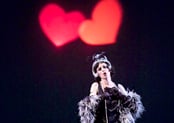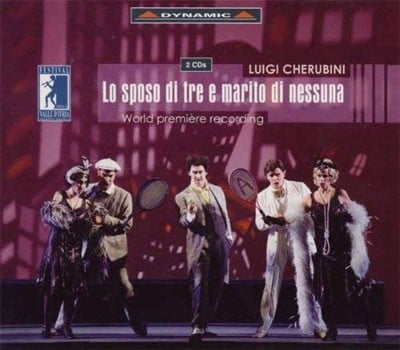OPERA SEARCH

Lo sposo di tre e marito di nessuna
(The Betrothed of Three and the Husband of None) (1783)Libretto by Filippo Livigni, based on Carlo Goldoni's "La bottega del caffè" (I)
3S,T,3Bar; 2.2.corA.0.1-2.0.0.0-continuo-strings
Abbreviations (PDF)
Anton J. Benjamin / Simrock
Teatro San Samuele, Venice
Company: (WP: Nov 1783, exact date unknown)
Palazzo Ducale, Martina Franca
Davide Livermore, director
Conductor: Dimitri Jurowski
Company: Orchestra Internazionale d’Italia
| Donna LISETTA, Baroness, sister of Don Martino | Soprano |
| Don MARTINO, Captain | Tenor |
| Don PISTACCHIO, Baron of Lago Secco | Baritone |
| Donna ROSA, Baroness, fiancée of Don Pistacchio | Soprano (Dramatic) |
| Don SIMONE, uncle of Don Pistacchio | Baritone |
| BETTINA, street singer | Soprano (Soubrette) |
| FOLLETTO, dicer, suitor of Bettina | Baritone |
| Servants of Don Pistacchio, Donna Lisetta and Donna Rosa, village people, musicians |
A baronial palace and its surroundings near Naples
Don Simone is looking for a match for his nephew, Don Pistacchio, a young, wealthy gentleman, that befits his rank. His choice is the baroness Donna Rosa, who willingly sends him a portrait. The messenger, though, Don Martino, is not quite the right choice, as he himself is keen on the baroness. He swaps the picture of Donna Rosa with that of his sister, Donna Lisetta, who is also on the lookout for a suitor. Soon the first of the two matches, Don Pistacchio and Donna Lisetta, is settled. Now Don Martino awaits Donna Rosa. Her arrival in tha palace of Don Simone and Don Pistacchio causes slight misunderstandings. Ironically accompanied by two comedians, a disaster unfolds, which leads to Don Martino threatening Don Pistacchio with a duel, and finally to the total mental confusion of those present.
In the second act, two advocates are called upon to unravel the problem. However, they are actually Don Martino and his sister in diguise, which makes the two ladies decide to depart. At the last minute they change their minds, because Donna Rosa, to the great dismay of Don Martino, has her eye on Don Simone, while Donna Lisetta contents herself with Don Pistacchio. When the plot threatens to get out of control, it is decided to consult a (fake) oracle. Its ominous answer is: Don Pistacchio will end up empty-handed. Nonetheless he approaches the comedienne Bettina. The plot thickens again, and a game begins, which is to have a surprising result …
Helen Geyer
Cherubini’s Lo Sposo di tre e marito di nessuna was a big success – indeed, the composer’s first successful opera buffa. The work, which was premiered at the Teatro di San Samuele in Venice in 1783, showed Cherubini’s talent for the “other” opera genre, the burlesque, the comic opera, or dramma giocoso. He based his piece on a popular, satirical and parodistic drama, Goldoni’s La bottega del caffè. This burlesque play about dressing up and mistaken identity draws heavily upon the tradition of the Italian commedia dell’arte, with the pair of actors, the reflections on the love-stricken elderly gentlemen, the parody of Pantalone, the advocate scene, etc.
The music of this opera is a cavalcade of highly amusing, sometimes also deadly serious ensemble scenes which are effectively orchestrated. This is illustrated by the big chain finali, in particular the finale of the first act, in which all those involved eventually end up in a state of delirium which is accompanied by a delicious parody of thundering organ sounds, or the ombra scene, a spooky, bogus consultation with a ghost in the second act. On the other hand, there are highly virtuoso, sometimes touching arias that demand great skill from the female protagonists, Donna Rosa and Donna Lisetta, both of whom are seria characters. The male protagonists range from the wonderful baritone buffo Don Pistacchio, who also needs to be a very good actor, to the tenor Don Martino, a character who is sometimes portrayed in a rather sentimental way. Originally, two ballets were planned to form part of the opera, as an introduction and conclusion. The interpretation of these are now left up to the individual production – just as it was in Cherubini’s times.
"First performed in 1783, three years before Mozart’s Le Nozze di Figaro, this playful, charming score foreshadows much of the rhythmic vitality of the later masterpiece’s score… The storyline points a little further ahead, however, to some of the cynicism about human amatory impulses depicted in Così fan tutte… An opera well worth reviving, both for its inherent musical quality and the insights it provides to a rich era of operatic history.”
Opera Today
Comic

Festival della Valle d’Itria, Martina Franca 2005 (FP of new edition)
Dynamic CDS 503/1-2
Click here to purchase this CD from Amazon
